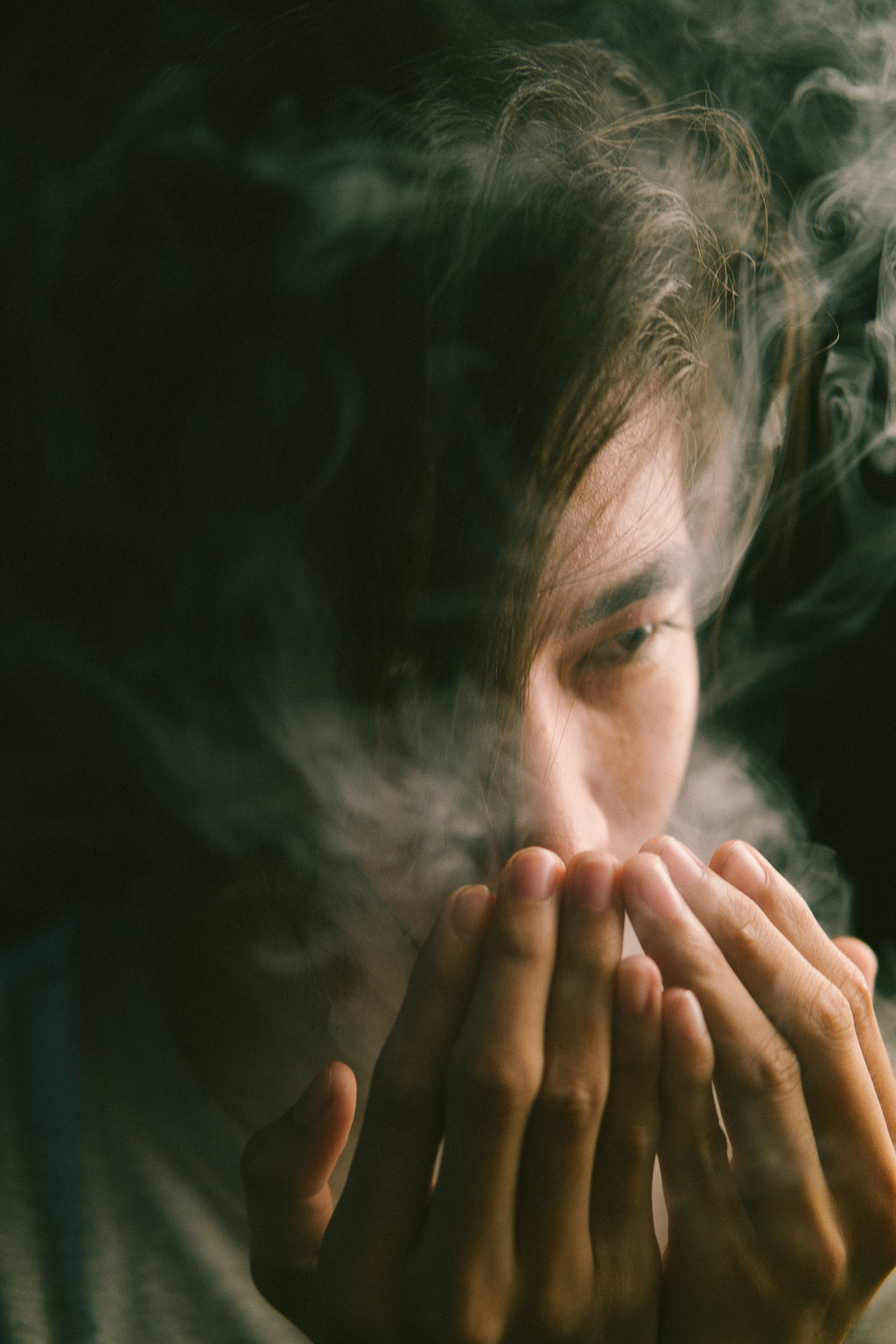How to use BreathWork to improve health and reduce anxiety.

Click to Jump ahead to one of the following chapters:
2. Utilizing breathing techniques to ease marijuana side effects
4. Benefits of proper breathing
5. Health boosting breathing methods
Whether you are new to cannabis or an expert user, your body won’t necessarily react the same way every time. Cannabis can work exactly the way you plan it, but a new strain or different dosage can throw you off unexpectedly. Especially with high -THC content, you might experience side effects, like stress, anxiety, or even panic attack.
In this article, we are going to talk about the importance of proper breathing and how to utilize it to take back control over your mind and body and to ease the side effects of marijuana.
Breathing is such a basic and essential part of life that we don’t even think about it much. It has been on autopilot since day one, but what if there is more to it.
Breathing sets the rhythm of everything, it is quintessential to our existence, but since we do it intuitively, might be hard to wrap your mind around the idea, that most of us breath improperly or at least less than optimally.
Let’s see what a good ol’ deep breath can do to our overall wellbeing.
When we are talking about taking a conscious deep breath it means to we inhale slowly and deeply through our nose and exhaling completely also through our nose.
I want to emphasize the word completely here since the majority of us almost never exhale the entire volume of air from our lungs which in time causes us diaphragm to lack the full range of motion and that leads to superficial breathing.

Practicing conscious deep breathing for 3-5 minutes any time during the day can have tremendously positive effects on your health. Why? Clean oxygen travels through your body, your brain, your heart, that can ease depression, helps relaxing, eases headaches, lowering cortisol (stress hormone) level in the body. While this all sounds great, practicing mindful breathing does more, than alleviate a bit of anxiety.

Breathing techniques are not a newly found trend. The power of breathing techniques has been known and passed down from generation to generation since the dawn of humanity. Spiritual seekers and yogis have often utilized different techniques because they believed that breathing is the connection between mind and body since it is the only bodily function that we can do both consciously and unconsciously. By altering their breath these masters could shift their consciousness, reach an altered state of awareness, and thus gain control over their body temperature and other functions which are normally out of our reach.
They also found out that many diseases were the result of improper, inefficient breathing.
so, breathing techniques were used to heal the body, to reach mental, spiritual, emotional, and physical wellbeing.
If you have ever attended a yoga class or tried mediation you already know, that all starts with breathing. It helps you focus, reach a certain state of mind, and relax.
By now we know quite a lot about cannabis, its benefits, and also a few side effects. However, we cannot expect our body to react the same way every single time since there are many factors that can play a role in this situation. We can be tired, our hormones can be off, even the weather can affect our mood, not to mention everyday stress. We also try new strains from time to time, but even the strains that have the same name from different growers can have a slightly different effect.
Cannabis-induced anxiety can result in panic attacks, which can cause shaking, sweating, intense feeling of fear, rapid heartbeat, uneven, fast breathing, chest pain, nausea, dizziness, or numbness, really the symptoms can be off the chart.
Anxiety and panic attack feels terrible, it is not life-threatening and it can go away fairly quickly. However, our judgment is clouded in these cases and we can’t think clearly, so 10-15 minutes can feel like an eternity.

The best way to treat hyperventilation, panic attacks, or even light stress caused by cannabis or really anything, is to focus on your breath.
Try these exercises the next time you are feeling anxious or panicked
____1_____________________________________
Try this simple technique if you feel anxiety slowly creeping up on you
Sit comfortably with a straight spine, and place your hand on your knees or where it is. This exercise helps you relax and get centered.
Syncronize your breathing with the animation below.

- Count to five in your head while taking a deep breath through your nose.
- Hold it for a moment
- Count to five in your head, while exhaling through your nose as well
- Try to focus on your breath and the sensation of the air on your nostrils while doing this exercise.
____2_____________________________________
Try this breathing technique when you feel tension and fear
Sit down and push your back against the wall. Close your eyes
- Place your palms on your face and close your ears with your thumbs.
- Place your index fingers on your forehead, and rest three fingers on the side of your nose, slightly covering your eyes
- Inhale slowly and deeply through your nose
- Exhale through your nose with a closed mouth, while making humming sounds
This exercise lowers blood pressure, and vibration created by humming reduces negative energy, stress, and fear.
____3_____________________________________
Try this exercise when you feel irritated and hopeless
Sit down on a chair or your bed

- Close your right nostril with your right thumb
- Breath through the left nostril deeply, and slowly
- Close your left nostril with the same hand middle and ring finger
- Release right thumb from the right nostril and exhale
- Inhale again from the right, switch nostril and exhale through left
- Now inhale from left switch fingers and exhale through right
You are going to exhale and then inhale in one nostril, switch and repeat this with the other one.
Keep doing this exercise until you feel better. Aim for 25 repeats first and see how you feel. Keep going if you still feel anxious.
__________________________________________
Luckily, we began to recognize, that the ancient teachings are filled with remedies to modern day problems. One of the great publications about the importance of breathing is James Nestor’s book: Breath: The New Science of a Lost Art.
Journalist, James Nestor was seeking a resolution to his reoccurring pneumonia and bronchitis. During his research to his book, Nestor participated in a study, in which he was forced to breathe only through his mouth for 10 days. The result was shocking. Improper breathing caused severe snoring, which affected his sleeping, he developed sleep apnea, and his stress level was extremely elevated.
Besides the study, he searched the world for answers, tracking down men and women who can help him understand the hidden science behind ancient breathing practices like Pranayama, Sudarshan Kriya, and Tummo


Current research shows us, that practicing different breathing exercises can jump-start our whole body. It can enhance athletic performance, refresh our internal organs, ease asthma, autoimmune disease, and allergies. Relieves stress, calms the mind, and helps with panic attacks.
Our nose was naturally made to breathe through it, because only the nasal pathway is equipped to heat up and filter the air. Breathing through our nose triggers hormones, it can lower blood pressure, evens heart rate, and keeps our body in balance. Inside the nose lies a whole network of neuro sensors that constantly monitor the air that we inhale or exhale and sends signals to the body to react to those signals appropriately.

In his book, Nestor explains how researches were shocked to find that our ancestors from a hundred thousand years ago had twice the size of nasal pathways. These ancient remains tell the story of how our modern-day skull anatomy changed over time presumably because of a major change in our diet and our growing frontal lobe. This change consisted of us losing a large portion of facial bones shrinking our noses along with the nostrils and the nasal passageways. This change also caused our jaws to become smaller and smaller which is why researches say, we are now struggling with crooked teeth. The skulls of those early humans all have perfectly straight and surprisingly healthy teeth. Nestor also makes the connection between the shrinking of our nasal apparatus and snoring or chronic sleep apnea.
The other very important aspect of proper breathing is the number of breaths we take or better said the amount of air we inhale per minute. This has to do with the amount of carbon dioxide in our body. A little-known fact is that carbon dioxide is just as if not more important than oxygen. If we don’t have enough CO2, our body can not process enough oxygen. It is called over breathing, which means breathing too fast. This causes an increased heart rate along with poor oxygenation of the body.

After studying this phenomena Nestor found that the ideal breath cycle is 5.5 seconds inhale and 5.5 seconds’ exhale. This slow but steady pace of breathing insures the best oxygen to CO2 ratio.
Here’s a little animation to help you with keeping this breath rhythm. Synchronize your breathing with the animation for a few minutes and see how you feel.

There were many people throughout our history who came across the miraculous healing power of breathing techniques but sadly whether they were trained medical professionals or just self-thought pulmonauts their techniques and sometimes incredible results all but faded into oblivion. Modern medicine completely disregards breathing methods as a way to treat certain health problems although when we unearth some old, forgotten studies it becomes clear that it is never to late to extend our lung capacity with conscious breathing techniques.

One of the more interesting symptoms of our modern, office dwelling lifestyles is shallow breathing. Shallow breathing is the drawing of minimal breath into the lungs, usually by drawing air into the chest area using the intercostal muscles rather than throughout the lungs via the diaphragm.
We do this without even noticing throughout the day and studies show that some people even stop breathing for short periods of time without ever being aware of it. This type of unconscious breath irregularity is potentially very harmful but ironically if we do conscious breath restriction or breath extension it can be extremely healthy and useful to take back control of our breath and thus eliminating or at least reducing unhealthy breathing habits.
Shallow breathing as mentioned above uses very little of the diaphragm and because of this our lung capacity slowly decreases over time. Pulmonauts of the past who recovered from debilitating illnesses by using extreme forms of breathwork to extend their lung capacity not only achieved to regain their health but managed to extend their life significantly. Nestor also talks about a study was made to find the most important factor when it comes to longevity and surprisingly the one thing that made the biggest difference was lung capacity. The bigger the lungs capacity the longer the person lived regardless of diet, geographical location and even prior health issues.
(Never attempt these techniques while driving, while underwater, or in any other conditions where you might be injured should you become dizzy)
Buteyko breathing
The point of this technique is to train the body to breathe in line with its metabolic needs. For the most of us this means breathing less.
- Sit up with a straight back- Pinch both nostrils closed with the thumb and forefinger of either hand, then exhale softly out your mouth to the natural conclusion.
- Start the stopwatch animation and hold the breath
- When you feel the first potent desire to breathe, note the time and take a soft inhale
- It’s important the first breath in after the control pause is controlled and relaxed; if it’s labored or gasping, the breath-hold was too long. Wait several minutes and try again.
Click the start button to see how long you can hold a pause breath.
Thousands of Buteyko practitioners, and several medical researchers, swear by it to stave off asthma and anxiety attacks.
Box breathing
Navy seals use this technique to stay calm and focused in tense situations.
Inhale to a count of 4; hold 4; exhale 4; hold 4. Repeat

4-7-8 Breathing
This technique places the body into a state of deep relaxation.
- Take a breath in, then exhale through your mouth with a whoosh sound.- Close the mouth and inhale quietly though your nose to a mental count of four.
- Hold for a count of seven.
- Exhale completely through your mouth, with a whoosh, to the count of eight
3-9 Conscious Breathing
- Inhale 3 seconds
- Exhale for 9 seconds.
-Repear the cycle for 10 times

Yogic Breathing
- Sit cross legged on a chair or on the floor and relax.
- Breath deep into your belly
- Once your belly is expanded, concentrate on and inflate the area at the bottom of your rib cage or what commonly is called the solar plexus
- Lastly, finish inhaling by expanding the upper part of your chest
- Try to to the same as you exhale in reverse, deflate the upper chest, solar plexus and lastly your belly
- Repeat this sequence for about a dozen times

We hope you found this article not only enjoyable but useful and remember: breath well to be well :)








